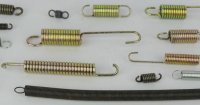在现代工业应用中,钢板弹簧被广泛应用于各种机械装置和设备中,因其具有高强度和弹性以及抗疲劳性能而备受青睐。然而,在使用钢板弹簧的过程中,了解其拉伸表面的特性是至关重要的。
钢板弹簧的拉伸表面
钢板弹簧的拉伸表面是指在被外力拉伸或压缩时,钢板弹簧表面的形变情况。拉伸表面的特性对钢板弹簧的性能和寿命有着重要影响。
首先,拉伸表面的光洁度对钢板弹簧的工作效果有直接影响。一个光滑的拉伸表面可以减少摩擦力,提高弹簧的运动效率,从而减少能量损耗。因此,在制造过程中,应尽可能保持钢板弹簧的拉伸表面的光洁度,并通过表面处理来提高其表面质量。
其次,拉伸表面的粗糙度会影响钢板弹簧的疲劳寿命。研究表明,粗糙的拉伸表面会导致应力集中和裂纹的产生,从而降低弹簧的寿命。因此,在制造过程中,应通过表面处理来降低钢板弹簧拉伸表面的粗糙度,提高其疲劳寿命。
此外,拉伸表面的形状对钢板弹簧的工作性能也有重要的影响。一个平整的拉伸表面可以保证弹簧在工作中的稳定性和准确性。而不规则或变形的拉伸表面会导致弹簧在工作中产生振动或失真,影响其工作效果。因此,在制造过程中,应保证钢板弹簧的拉伸表面形状的精确度和一致性。
钢板弹簧拉伸表面处理方法
为了提高钢板弹簧的性能和寿命,常用的拉伸表面处理方法有以下几种。
1. 磨削
磨削是常见的表面处理方法之一,通过使用磨削工具对钢板弹簧的拉伸表面进行精细加工,以降低其粗糙度和提高光洁度。磨削可以消除拉伸表面的不平整和瑕疵,提高其质量,从而提高钢板弹簧的工作效果和寿命。
2. 抛光
抛光是一种常用的表面处理方法,通过使用抛光工具和磨料对钢板弹簧的拉伸表面进行加工,以降低其粗糙度和提高光洁度。抛光可以使钢板弹簧的表面变得光滑、亮丽,并消除表面的微小划痕和氧化物,提高其耐腐蚀性和寿命。
3. 镀层
镀层是一种常用的表面处理方法,通过在钢板弹簧的拉伸表面上涂覆一层金属或非金属材料,以提高其整体性能。常用的镀层方式有镀锌、热镀锌、电镀等。镀层可以增强钢板弹簧的耐腐蚀性,提高其使用寿命。
4. 喷涂
喷涂是一种常用的表面处理方法,通过将特殊的喷涂液喷洒在钢板弹簧的拉伸表面上,形成一层保护膜,以提高其耐腐蚀性和耐磨性。喷涂可以保护钢板弹簧的表面不受外界环境的侵蚀,延长其使用寿命。
结论
钢板弹簧的拉伸表面是其性能和寿命的关键因素之一。一个好的拉伸表面可以提高弹簧的工作效果和寿命,降低能量损耗和维护成本。因此,在制造和使用钢板弹簧时,应注重拉伸表面的处理和保护,采用适当的表面处理方法,以提高钢板弹簧的性能和寿命。
In the post, we discuss the characteristics of the '钢板弹簧的拉伸表面' (tensile surface of steel plate springs) in modern industrial applications. We emphasize the importance of understanding the properties of the tensile surface and its impact on the performance and lifespan of steel plate springs. The smoothness, roughness, and shape of the tensile surface are significant factors affecting the working efficiency, fatigue life, and stability of the springs. To improve the performance and lifespan of steel plate springs, several common methods for treating the tensile surface are described. These methods include grinding, polishing, coating, and spraying. Grinding and polishing processes are used to reduce roughness and enhance the smoothness and appearance of the surface. Coatings, such as zinc plating or electroplating, and spraying protective films help improve corrosion resistance and wear resistance. It is crucial to prioritize the treatment and protection of the tensile surface of steel plate springs during the manufacturing and usage processes. By utilizing appropriate surface treatment methods, the overall performance and lifespan of steel plate springs can be enhanced, ultimately reducing energy loss and maintenance costs.
 77
77 2023-08-14 06:52
2023-08-14 06:52 admin
admin
